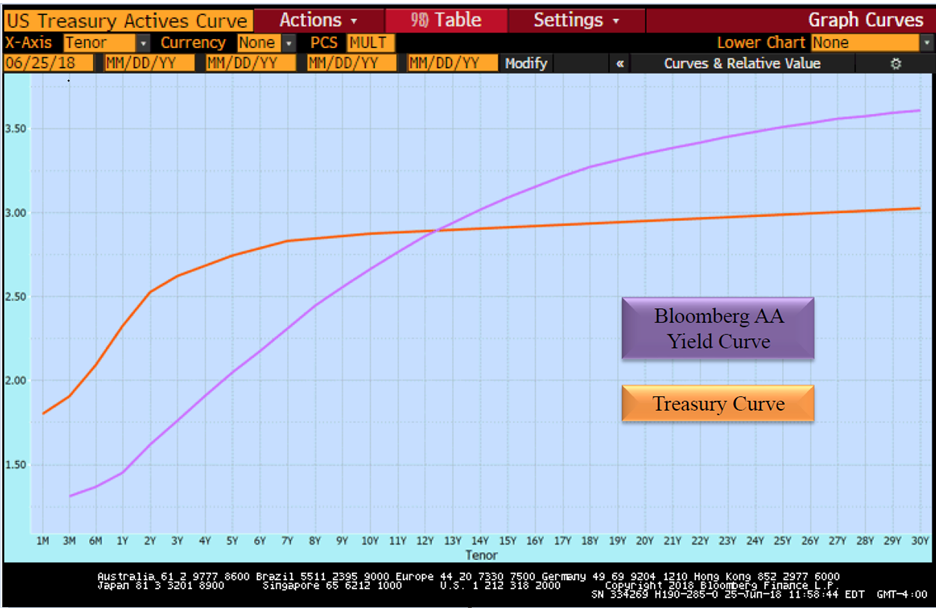The tax-free bond market has continued to benefit from the drop in supply so far in 2018. To recap, the end of 2017 saw a bulge in supply as issuers tried to beat the tax-cut bill that Congress was still massaging through joint Senate/House committee work. The final results of the bill were an elimination of advance refunding bonds but a continuation of private activity bonds. With the lack of clarity about aspects of the final bill, the supply of both advance refundings as well as private activity bonds mushroomed in early December, leading to a record amount – $63 billion of municipal bond issuance – in the last month of the year.
The offset to the huge uptick in supply in December 2017 has been a drop in supply this year. Through the first five months of the year, new-issue supply has dropped from $161 billion at this time last year, to $126 billion. We have also seen demand pick up, particularly in high-tax states. Many states are seeing an increase in demand because, under the new tax bill, state income taxes as well as local property taxes are no longer deductible on federal taxes; thus the taxable equivalent yield for high-tax state bonds from California, New York, Minnesota, and other high-tax states has risen.
The relative improvement in the tax-free bond market can be seen in the table below.

As the Federal Reserve has continued to hike short-term interest rates, we have seen improvement in the tax-free muni/US Treasury yield ratios. The second quarter so far has continued a trend we saw in the first quarter, with yield ratios in the short end of the curve moving lower. Longer-term yield ratios have also moved lower, but the effect has been a little less dramatic than in the short end.
All of this makes a lot of sense in an environment where shorter-term interest rates are moving up because the Federal Reserve is raising rates in the face of an ever-improving economy. If the average tax rate in this country is close to 25%, then only a 75% move in a muni tax-free rate is needed to equal whatever the equivalent rise in Treasury yields is. We believe the longer-maturity muni/Treasury yield ratios will trend lower as the Fed’s hike cycle continues into next year.
In addition, most tax-free yields are NOT on the AAA curve but usually decently above it, with most AA and A-rated bonds trading 40–80 basis points or more above the AAA curve. Thus the longer end of the tax-free bond market still offers superior value in our view. This is why we continue to employ a “barbell” approach to our fixed-income management, particularly on the tax-free side.
Below is a graph showing the U.S. Treasury yield curve and the Bloomberg AA tax-free yield curve:

We can see that the muni yield curve is fairly well behaved from a ratio standpoint out to 7 years, then it cheapens and crosses the Treasury curve and yields continue to rise, even though the Treasury curve is lower – and flatter. One factor here is that longer Treasury yields have stayed lower ever since President Trump was elected. One of the reasons is that inflation has continued to be stubbornly low, and low inflation has been reflected in long Treasury yields, which have also stayed low. Another factor is that US government yields continue to be much higher that sovereign debt yields in other developed countries. In our view, the longer tax-free yields with yield ratios well over 100% provide a safe haven for bond assets if this ratio moves LOWER over time (as it did during the 2004–2006 period – the last time the Fed raised short-term interest rates).
Thus we have the two parts of the barbell – on the one hand, owning shorter-term assets that can roll over quickly and be reinvested in higher-yielding short-term bonds as the Fed raises short-term rates. And, on the other hand, owning long-term munis, which provide much higher incremental yield than longer Treasuries do as well as short-term taxfree bonds. In addition, the cheap muni/Treasury yield ratios provide a life jacket to the duration risk of longer bonds. In other words, even if long Treasury yields rise, a return to a more normalized 100%-or-below yield ratio will buffer price erosion of longer tax-free munis.
Finally, a quick word about the Internet Sales Tax Decision announced late last week by the Supreme Court. The Supreme Court found that businesses did not need a physical presence in order for states to levy a sales tax in their respective states. Thus, sales of goods on the internet will now be able to be taxed, generally by the states in which they are purchased. The fact that we have Justices such as Justice Ginsburg and Justice Thomas on the same side of an opinion suggests that common sense prevailed here. Certainly, states that are more highly dependent on sales tax revenues will benefit from this ruling. The fact that the Supreme Court superseded its earlier ruling on this (Quill case) is also refreshing in that the Justices now recognize that technology has changed the original premise of the Court’s thinking. At Cumberland, we think this decision means greater debt service coverage for various sales-tax-backed bonds, and we would expect to see an improvement in their trading values.
And lastly, as we go to press, the U.S. Supreme Court has ruled that government workers who choose not to join unions may not be required to help pay for collective bargaining. Though this case was decided on First Amendment issues, it has broad positive implications for state and local governments to craft solutions to the pension issues facing them. We will write more on this important decision in the next few days.
[1] Figures pulled from Decade of Muni Finance, published by Bond Buyer.
